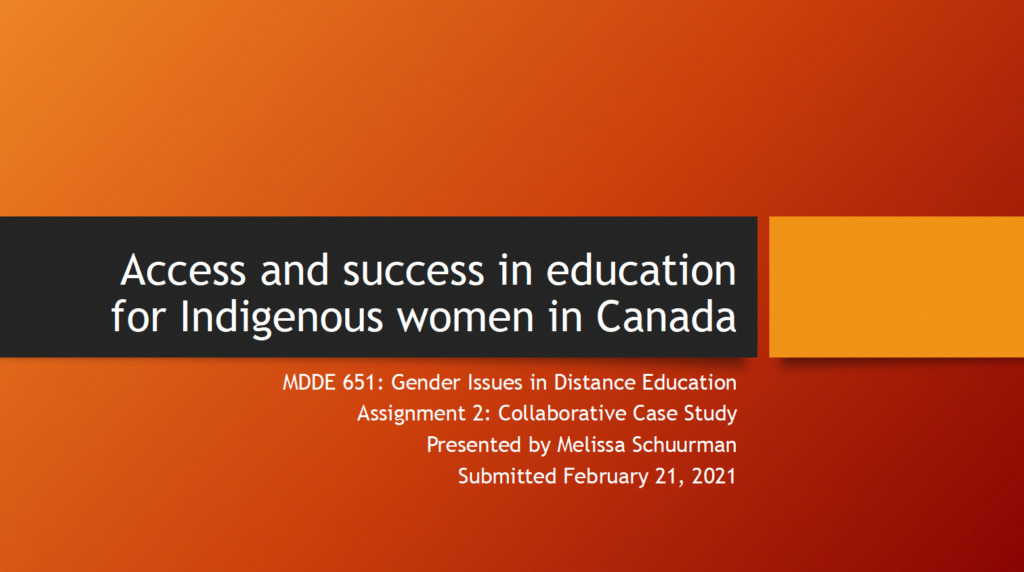Case Study
My fourth artefact is from the second assignment I completed for MDDE 651: Gender Issues in Distance Education. This was meant to be a collaborative case study, but due to the odd number of people in the class, my instructor asked me if I would be willing to do this assignment on my own. The assignment was a forum presentation, where each group took turns facilitating and moderating discussions on the topic they presented on. We were able to choose the format of our presentation, so I chose a video presentation with slides and voice-over and provided three questions for discussion during my week of facilitation. As the course primarily focused on feminist theory, we had to choose a topic around educational access issues for women. I chose to look at access and success in education for Indigenous women in Canada.
Why this artefact?
MDDE 651 was one course I was most excited about taking in this program. Previously, my knowledge of feminist theory was very limited, so I wanted to learn more. With this assignment, I was able to highlight and raise awareness of an issue that is still very prevalent in our society. Although Canada is considered a developed country, there are many regions which remain less developed than urbanized centers. This can negatively impact community and individual access to things such as education. Indigenous peoples in rural areas, particularly women, face even greater barriers to access due to race and gender. I know that some people believe issues with access to education is only a real issue in underdeveloped parts of the world. I wanted to help raise awareness to access issues in Canada, I know that Indigenous peoples in Canada still have limited access to a variety of resources, and it was something I wanted to learn more about.
This artefact demonstrates elements of the following MEd program competencies which are noted in parenthesis in my reflection:
- 4. Communication & Interpersonal Skills
- 4.1 Write clearly and in a style appropriate to purpose (e.g. assignments, reflective essays or journals, published documents, blog posts, eportfolios, and theses).
- 4.7 Demonstrate effective design, delivery and critical evaluation of presentations, online forums, webinars, or seminars
- 5. Research
- 5.2 Identify, discuss and apply theoretical considerations to proposed research.
- 5.3 Identify and critically evaluate sources and content for quality, applicability, and relevance
- 5.4 Formulate effective/appropriate search terms in library searches
- 5.5 Critically review literature both broadly and in-depth.
- 5.6 Formulate questions and reasoned arguments, leading to rational conclusions
- 5.8 Effectively communicate information, arguments, and analyses in the discipline of open and digital education, in a variety of forms, to suit different contexts and audiences.
- 5.9 Critically analyze the issues and discuss the wider implications affecting the use of information
Reflections on Artefact 4

When looking back on starting this assignment, it felt very daunting. As with my previous artefact, I would like to acknowledge that the Thompson Rivers University campuses are on the traditional lands of the Tk’emlúps te Secwépemc (Kamloops campus) and the T’exelc (Williams Lake campus) within Secwépemc’ulucw, the traditional and unceded territory of the Secwépemc. Our region also extends into the territories of the St’át’imc, Nlaka’pamux, Nuxalk, Tŝilhqot’in, Dakelh, and Syilx peoples.
I wanted to focus purely on the research I was able to access, and not on any assumption I may have had. It was important that I look purely at the facts. When I first started doing the research, it was difficult to find Canadian-specific research in educational access, so I had to broaden the scope (5.3, 5.4). The Canadian-specific research had more to do with employment than access to education. Thankfully, I was able to find a few articles specific to education, and able to tie in the employment success research, as employment success can be tied to educational level. My research also uncovered issues with those living in rural areas versus urban areas. As many Indigenous peoples live in rural communities across Canada, it was also important to look at this. I realized that starting with a narrow scope on education was limiting the full picture (5.5). The issue with access to education was not just an education issue, but an economical issue so it was important to enlarge the scope (5.9).
I’ve highlighted some of things I learned through the research I gathered for this project (5.2, 5.6):
- Research into rural has historically been tied to societal perceptions and assumptions that are homogenous and ignore Indigenous populations
- There is a long-standing history in Canada of systemic and institutionalized racism and sexism when it comes to Indigenous peoples that have limited their access to aspects of society, such as formal education
- Indigenous women face what is called “double discrimination” or “multiple jeopardy” because of their gender and race, which makes it even harder for them to have accessible education (these were new terms for me and a real eye-opening)
- Distance education has the potential to help reduce the barriers that Indigenous women face in accessing education
Reviewing research that emphasizes the benefits of distance education in reducing barriers to education has made me, once again, proud of the field I am working in. I have heard many stories of how TRU Open Learning has helped changed peoples’ lives for the better. The research showed that distance education can help reduce social barriers that negatively impact race and gender, so it has the potential to support Indigenous women succeeding in accessing and achieving their educational goals (5.8).
As stated before, for my presentation I put together a video with slides and audio recording (4.1, 4.7). I uploaded my presentation to my university’s Kaltura media site, like YouTube, so that it would be easily accessible through any web browser. I also included the discussion questions in the video for the forum discussion so that the presentation was still fresh in people’s minds when they thought about the questions. I have included the video presentation below:
https://media.tru.ca/media/MDDE+651+A2+presentation/0_qc11f2mg
I have also included the discussion questions below for reference:
- What can be done to address the social challenges that Indigenous women face when it comes to accessing education?
- What can be done for Indigenous women who have successfully achieved the highest level of education, but still experience inequality due to their race and gender?
- What role does distance education play in working to improve access and success for Indigenous women, specifically those in rural communities?
I received a lot of positive feedback on this presentation and the discussion portion of the project was very engaging. People picked up on the “multiple jeopardy” term and said that it really resonated with them. Many agreed that, while a lot of work has been done to improve access to education, there is still a long way to go to create equity.
Another area of discussion was around the fact that “home” is not always a safe place for women, and that is something that needs to be considered with distance education and there should be mechanisms in place for women to connect with one another in a place outside of the home environment. There still needs to be some form of in-person supports, even when the education is delivered remotely. This was also part of a conversation I was a part of at the beginning of the pandemic, when work and school moved completely to remote. Some people were excited about it, but a colleague of mine raised the issue that this was not going to be easy for a lot of people. As we don’t know what goes on in everyone’s personal lives, we don’t know what the home environment looks like, whether it is a safe place to be in. He argued that the office could very well be a safe haven for those who have issues at home, and with the pandemic removing that option to leave a potentially harmful environment, it could be a very damaging experience for many without us even realizing it. I think that while distance education provides options that traditional education does not, it does not provide a physical space for those who may need that relocation to feel safe, even if it’s just for a couple hours of class time. The pandemic resulted in many feeling an increased amount of isolation, and I think especially for women in rural areas. Many who commented in the discussion felt the same way, and the idea of maintaining connections was prominent in the discussion.
This whole experience was very eye-opening, for myself and my classmates. I think we were all aware of the access issues, but I don’t think how it was part of a whole bigger issue. We, as a society, have a long way to go, but I think the first step in this is learning and acknowledging where the gaps are, then finding the best way to fill those gaps. It’s going to be a collaborative effort and growing experience. I don’t think it’s going to happen overnight, but it is something that needs to happen.

Kate
Melissa, I had mentioned in another comment in someone’s e-portfolio that I really regret not taking MDDE 651 and your project really just made that regret a bit stronger. Again, excellent work. What I found to be so impactful was when you said, “Some people were excited about it, but a colleague of mine raised the issue that this was not going to be easy for a lot of people,” when you talked about shifting to working remotely from home. I think safety is something that can be so often taken for granted, even though it is a right that should be present in the lives of all women. Very powerful work here, I appreciate you sharing and I am grateful that I took this course at the same time as you. You’ve done incredible work here.
Melissa
Thank you Kate! MDDE 651 was a rewarding learning experience for me, I’m very thankful I was able to take it.
Melissa